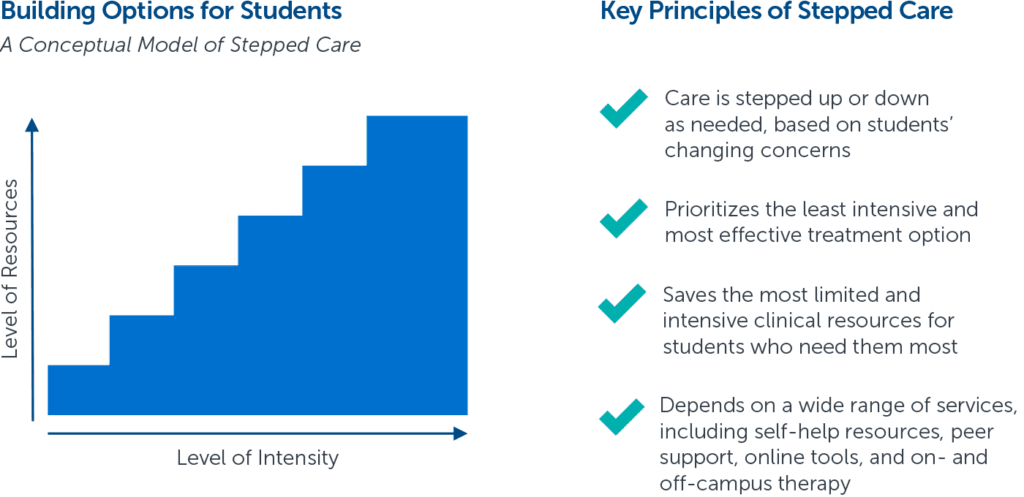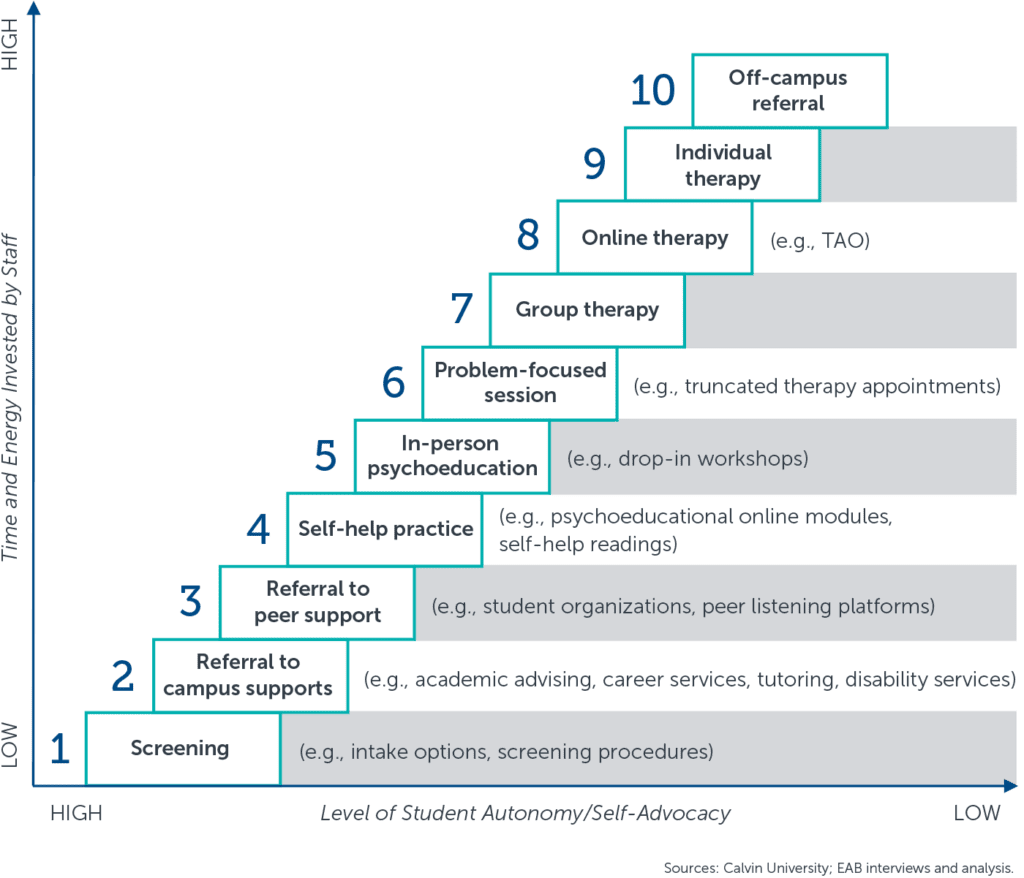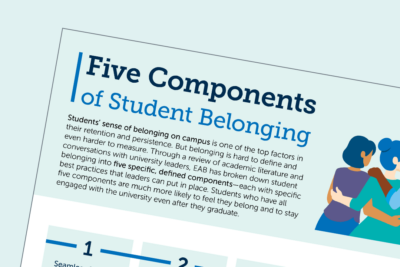Use this guide and template to build out a comprehensive mental health stepped care model for your institution.
A stepped care model for campus mental health services provides an array of mental health support options for students that allow them to step-up or step-down the intensity of care as needed.
In this model, individual therapy is just one care option among a much larger suite of services, often ranging from online self-help to off-campus care. The stepped care model allows institutions to map campus support services and mental health resources to students’ levels of need and risk.
This guide and template references Calvin University’s stepped care model and the success they realized after the first year of implementation. Throughout, you will see other examples and comments from universities who are currently using a stepped care model and what worked for them.

How to use this resource
- Review the example from Calvin University to see the different types of interventions and methods of care that can be incorporated into your model, and how Calvin has mapped them based on level of need and intensity.
- Use the outline based on Calvin University’s model to brainstorm the online, campus, and community resources that are available to students on your campus. Begin to map them to the outline to reveal where you may need to invest more to round out your stepped care model or where you want to modify steps for your campus context.
- Use the provided template to create your institution’s stepped care model.
Recommended next steps
Once you establish a stepped care model, it is important to communicate it with students, families, and campus partners. EAB recommends posting it online and through social media (with hyperlinks to relevant resources and information pages) and posting hard copies across campus.
Expand how students perceive mental health care on campus
Calvin University Advertises an Array of Resources
When students think about mental health care on campus, many of them only picture individual therapy appointments. For a stepped care model to be successful, institutions need to help students expand their understanding of what mental health care can be. As part of their stepped care model, Calvin University created the graphic below to advertise the broad array of mental health resources available to students.

Each step features resources of varying intensity that students can access on campus and in the community. For example, step two showcases campus supports such as health services, student success, and group fitness. Step four includes self-help practice and psychoeducation resources such as apps and websites.
Calvin University’s model is effective because it incorporates an array of resources that range in intensity.
The model prompts students to broaden their perspective of mental health support, promotes campus supports alongside traditional mental heath resources, and maximizes existing campus resources, including staff and services, while helping to alleviate the demand for traditional counseling services.
Stepped care model outline
Questions to consider:
-
What resources can students access online, either freely or through existing institution subscriptions?
-
What resources do you already have on campus?
-
What resources are available to students in the local community?
-
What resources might your campus need to invest in to more fully support students?

Success Story: Oak University*
In fall 2017, Oak University’s counseling center was short-staffed and struggling to meet student demand: the average wait time for care was 11-14 days after initial screening. The counseling center provided only one type of care—namely, individual counseling—which hamstrung efforts to expand mental health offerings to more students and reduce wait times.
In order to “sound the alarm” and rally the broader campus around mental health issues, the provost and the counseling center director presented EAB’s Explore the Demand for Mental Health Services with Campus Partners slides to a group of faculty and campus leaders. Then, he and the center director used EAB’s Stepped Care Model Template from the Meeting the Escalating Demand for Campus Mental Health Services study to remake their counseling center’s processing, intake, and care process.
They replaced their “individual counseling for all” model with the stepped care model and used EAB’s Self-Serve Technology Vendor Guide to explore technology-based therapy options, and decided to buy TAO, or Therapy Assistance Online, which is now fully integrated into their new stepped care model.
*Oak University is an anonymized small, private university in the Midwest
Ready to build your own stepped care model?
Quick tips to complete the template:
- Include online, peer, campus, and community resources
- Include resources outside of the campus counseling center
- Prioritize the top 3-5 resources per level
- Use language that is easily understood by students (e.g., avoid acronyms)
After you design your stepped care model, make sure to drive utilization of your institution’s array of resources. Vanderbilt University redesigned their triage process so that there was one centralized point of entry for all of Vanderbilt’s mental health and well-being services. Learn more in their case study.
More Resources

Student Experience and Well-being Resource Center

5 components of student belonging
